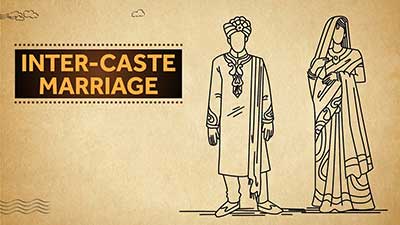Relevance: GS-1 : Effects of globalization on Indian society, Social empowerment
Relevance: GS-2 : Development and management of Social Sector/Services
Key Phrases : Indian Human Development Survey, anti-caste movement, Dr. Bhim Rao Ambedkar's Annihilation of Caste , fusion of blood
Why in News ?
- Recently, the Indian Human Development Survey reported that 95% of Indians still find partners within their subcastes.
Key Points
- During the anti-caste movement, intercaste marriages remained a hotly contested area during the freedom struggle. .
- Inter-caste marriages are seen as a way towards the annihilation of caste.
- Dr. Bhim Rao Ambedkar views on inter caste marriages:
- His famous quote from Annihilation of Caste, wherein he stated that inter-caste marriages were “the real remedy for breaking caste”, is often cited.
- Ambedkar thought “fusion of blood” would create the feeling of kith and kin.
- However, Ambedkar’s advice remains unheard.
- The Indian Human Development Survey reported that 95% of Indians still find partners within their subcastes.
- What is the situation of the rest 5%, who have braved the odds against tradition and caste? There isn’t very accurate data or satisfying coverage of them.
Key Observations
- Neo-Dalit Phenomenon: Many a time second- or third-generation educated Dalits who have managed to access quality education, and landed respectable (elite) jobs, find the prospects of marriage outside caste available to them.
- What then happens to Neo-Dalits inter-caste marriages?
- Their union is unlike any other marriage. It is a social act — an achievement of love over caste.
- Dalit person marrying outside caste, say to an upper caste, finds himself or herself duelling between the struggle of their community, and the culture of their spouses and in-laws.
- It’s akin to getting a good job in a company surrounded by oppressor castes. Rarely does one get a chance to balance both.
- Offspring of Mixed Bloods: The children of mixed-caste parents also
grow up amidst profound misunderstanding of their complicated backgrounds.
- They are brought up in a caste-neutral or a-caste environment, which essentially means being subjected to the dominant caste parent’s identity.
- The closest they come to caste is while availing caste reservations or visiting their Dalit family.
- If they align themselves with the identity of the oppressed caste parent, which is need-based, they risk a backlash.
- Government Efforts : The Government of India launched a scheme in
2013 to encourage inter-caste marriages.
- It offers Rs 2.5 lakh if one of the partners is a Dalit.
- One of the requirements is a recommendation from a sitting MLA / MP and government officer concerned.
- The scheme wants to appreciate and promote the “socially bold step” of the couple.
- When countries worldwide are now integrating rapidly across color, racial, ethnic boundaries, the Indian government has to offer more incentives for couples to marry outside rigid boundaries.
Does inter-caste marriage then result in the anticipated social change and abolish untouchability?
- Editor's own experience as an anecdote:
- A savarna woman in the US who married a Dalit man and joined the Dalit community’s network.
- Often, during interactions, the savarna woman wouldn’t parse her background. The Dalit community’s culture, religion and festivals were different from hers.
- Unknowingly, the savarna woman would privilege her experiences. At some point, she forgot about her caste identity and started to claim Dalit identity passively.
- Since she was a student and an activist, she profited from the networks offered by her Dalit compatriots.
- Within a matter of a few months, she was representing Dalits at conferences and seminars.
- What we see from the above anecdote is that the notion of inter-caste marriage has become a opportunity for those who have lived the life of oppressing Dalits directly or by virtue of their participation in anti-Dalit prejudices, to now assume the position of representing Dalits.
Recent observations made by the Supreme Court:
- The consent of the family or community is not necessary, once the two adult individuals agree to enter into a marriage. Their consent has to be given primacy.
- Educated youngsters are showing the way forward by tying the knot in inter-Caste-marriages.
- It will reduce caste and community tensions in India. Possibly, this is the way forward where caste and community tensions will reduce.
- The court also emphasized the need for specific guidelines and a training module for the police personnel. It will train them to handle cases of inter-caste marriage.
Conclusion
- Coming back to Ambedkar’s speech quoted above, he further suggested that to break the caste system, it was pertinent to destroy religious notions.
- The sanctity of the Shastras needs to be diluted on which caste was founded and not occasionally bring about “inter-caste dinner and inter-caste marriages, which were futile methods of achieving their ends”.
- What Ambedkar is arguing is not against inter-caste marriage, but he is inviting us to go deeper, beyond social sanctions. He wants us to be participants in movements that would upend and eventually change mindsets.
Source: Indian Express
Mains Question
Q. The Uniform Civil Code (UCC) cannot be disguised in the garb of protecting diversity, essential religious practices and constitutional morality. Comment. (10 marks)







